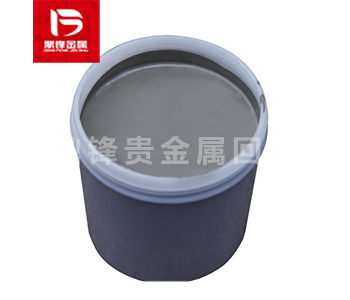
Palladium Slurry Recycling
Palladium slurry is a fine-grained substance that contains high concentrations of palladium metal particles suspended in a solvent. These palladium particles have nanoscale or submicron size and typically exhibit a gray or black appearance. The preparation process of palladium slurry can be achieved through different methods, the most common of which is chemical synthesis.is a fine-grained substance that contains high concentrations of palladium metal particles suspended in a solvent. These palladium particles have nanoscale or submicron size and typically exhibit a gray or black appearance. The preparation process of palladium slurry can be achieved through different methods, the most common of which is chemical synthesis.
- Parameter
- Related Questions and Answers
-
Name : Palladium slurry
-
Use : catalyst,Electronics Industry
-
Application Areas : Precious Metal Recovery,Jewelry and electroplating
-
Appearance and properties : Gray, black solution
-
Settlement Method : On-site payment
-
Recycling Type : Palladium recycling
-
Door-to-door recycling:worldwide
-
Customer service: Free content testing and door-to-door recycling
Palladium Solution Recycling
Palladium solution is a liquid containing palladium ions, typically in the form of palladium chloride (PdCl₂). It is created by dissolving palladium metal in an acid such as aqua regia. Palladium solution is widely used in various industrial applications, including precious metal recycling, catalyst preparation, and organic synthesis.Palladium solution can be recovered and reused through methods such as reduction precipitation, electrolytic recovery, and solvent extraction.These processes allow for the separation and purification of palladium, making it a valuable resource for industrial applications.
Search : Palladium Solution RecyclingPalladium Salt Recycling
Palladium salts typically exhibit white or yellow crystals with good solubility. Its melting point is relatively high, about 1554 ℃, and its density is 11.99 g/cm ³。 Palladium salts have good conductivity and thermal conductivity, making them an excellent catalyst material. Palladium salts are relatively stable in air, but are easily oxidized by oxidants such as nitric acid. It can form compounds with many non-metallic elements, such as Palladium(II) sulfide and Palladium(II) chloride. Palladium salts are usually divalent, and their Oxidation state can be+2 or+4.
Search : Palladium Salt RecyclingPalladium Tube Recycling
A tube made of metallic palladium is called a palladium tube (palladium alloy tube), and the size of the palladium tube used is mostly φ 20.08mm, can be used for the separation of hydrogen and impurities. The principle of palladium tube purification of hydrogen is that at 300-500 ℃, when the hydrogen to be purified is introduced to the other side of the palladium tube, the hydrogen is chemically adhered to the wall of the palladium tube and dissociated into hydrogen atoms. The hydrogen atoms and palladium atoms form alloy type hydrides, and the hydrogen atoms occupy the gap edges in the metal lattice, also known as interstitial hydrides. Under the promotion of concentration gradient, hydrogen atoms can spread through the walls of palladium tubes, forming a hydrogen molecular color layer again after passing through the tubes.
Search : Palladium Tube RecyclingPalladium Slag Recycling
Palladium slag is a byproduct or waste containing palladium element, usually generated during the extraction and processing of palladium metal. Palladium slag refers to the residue, waste or waste generated during the production or use of palladium metal, which contains compounds or mixtures of palladium elements.
Search : Palladium Slag RecyclingProduct Details
Palladium slurry is a fine-grained substance that contains high concentrations of palladium metal particles suspended in a solvent. These palladium particles have nanoscale or submicron size and typically exhibit a gray or black appearance. The preparation process of palladium slurry can be achieved through different methods, the most common of which is chemical synthesis.
The production process of palladium slurry: 1. Selection of palladium metal: The first step in preparing palladium slurry is to select high-purity palladium metal as the raw material. These metals typically exist in powder or sheet form and require strict quality control to ensure their purity and consistency in composition. 2. Dispersion of palladium metal: Mix the selected palladium metal with the solvent to disperse the palladium metal into small particles. In this step, surfactants or dispersants are usually used to increase the dispersibility of palladium particles and prevent their aggregation. 3. Cleaning and filtration: In order to remove impurities and insoluble substances, the palladium slurry is cleaned by filtration or centrifugation. This step helps to improve the purity and stability of palladium slurry. 4. Concentration and drying: By evaporating the solvent or other appropriate methods, the solvent in the palladium slurry is removed to concentrate the content of palladium particles. Subsequently, the concentrated palladium slurry is dried using appropriate drying techniques to obtain stable palladium slurry products. 5. Characterization and testing: Finally, the prepared palladium slurry was characterized and performance tested using various instruments and testing methods. These tests can include particle size analysis, surface morphology observation, chemical composition analysis, and physical performance measurement.
Waste palladium slurry is one of the sources of palladium containing waste recycling, including palladium water recycling, palladium paste recycling, palladium slurry recycling, palladium graphite recycling, palladium slag recycling, palladium mud recycling, etc. If you have any demand for palladium containing waste recycling, please call our 24-hour service hotline. Dingfeng Precious Metal Recycling and Refining Factory has independent recycling and refining factories without intermediaries to earn price differences. Our professional technical team and customer service personnel provide one-on-one services to ensure customer privacy during the recycling process.

